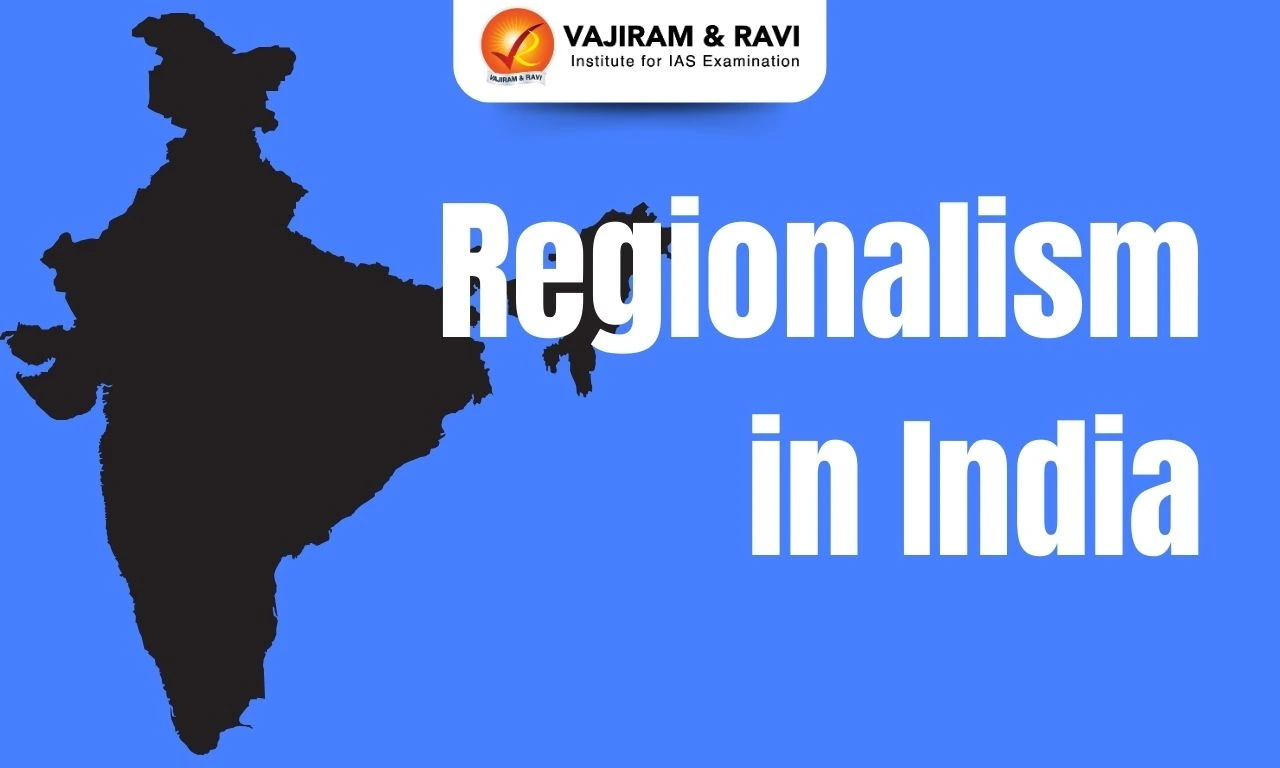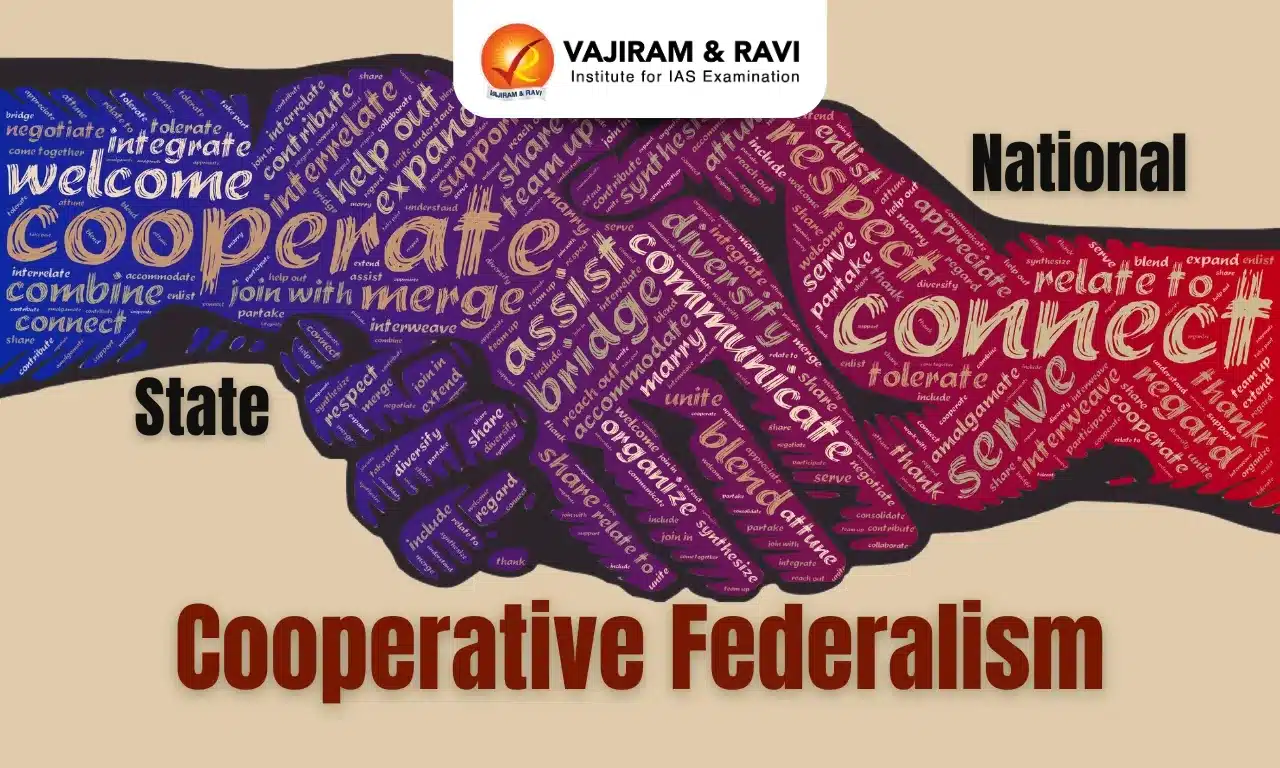What is Regionalism?
Regionalism is a term used to describe the idea that people living in a particular region share a common identity based on their distinct characteristics, such as language, culture, history, and food habits. This shared identity creates a sense of togetherness among people inhabiting a region.
- It is important to note that local patriotism and loyalty to one's locality, region, or state and its language and culture do not necessarily constitute regionalism
- However, regionalism can become problematic when the interests of one region or state are asserted against the country as a whole or against another region or state in a hostile manner.
- In the context of India, regionalism has been one of the biggest challenges for the consolidation of the country as a nation since its independence.
What are the factors that lead to Regionalism in India?
Regionalism is a multi-dimensional phenomenon, and various determinants work in tandem, such as
- Geographical factors:
- The geographical boundaries in India are closely linked to linguistic distribution, topography, and climate, leading to a territorial orientation among the inhabitants of a particular region.
- This induces a sense of regionalism in people based on their symbolic attachment to their region.
- Historical and cultural factors:
- In India, historical and cultural factors play a significant role in shaping regionalism. Cultural heritage, folklore, myths, symbolism, and historical traditions contribute to regionalism by inspiring a sense of pride and identity among people of a particular cultural group.
- Political and economic realities also influence regionalism under this factor.
- Caste and religion:
- When caste is combined with language conflicts or religious fundamentalism, it leads to dogmatism, orthodoxy, and obscurantism, further fueling regional feelings.
- Economic factors:
- Uneven development across different parts of India is a primary cause of regionalism and separatism.
- This disparity has led to a feeling of relative deprivation among the inhabitants of economically neglected regions, resulting in demands for separate states.
- Politico-administrative factors:
- Political parties and regional leaders exploit regional sentiments and deprivation to solidify their support bases by highlighting regional problems in their election manifestos and promising political and regional development to gain support.
How did Regionalism evolve in India?
Regionalism during the colonial era:
Regionalism in India had its beginning with the British policy of political conquests.
- The Imperial policies of Wellesley’s ‘Subsidiary Alliance’ to Dalhousie’s ‘Doctrine of Lapse’ sought to bring India under the direct and Indirect control of the company.
- The British policy towards Princely states was the beginning of Federalism, and the Princely states were the nuclei of regionalism in India.
- Further, the Decline of the Mughal Empire in the 18th Century left areas coming up as separate political units like Jats and Marathas, which helped re-assertion of their respective local identities.
Nationalist Movements and Regionalism:
The national movement in India was an aggregation of sub-national and regional identities.
- The primary goal of the national movement was to build an ‘Indian Identity’ among the masses.
- However, the national movements reflected the idea that regional identities do not counterpose national identities but rather go hand-in-hand.
- It can be concluded that during the national movement, regionalism co-existed with nationalism in India.
Regionalism in Independent India:
After Independence, initially, the Indian state continued with the British Indian arrangement of dividing India into large provinces, which are multi-ethnic and multi-lingual provincial states.
- These units of the colonial era had to be reorganized into linguistic states within the Indian union in response to strong popular agitations.
- At Independence, modern industrial development was concentrated in enclaves around Calcutta, Bombay, and Madras, which accounted for around 60% of India's total industrial capital.
- Also, the 1960s Green Revolution and the globalization and liberalization of the Indian economy in the 1990s widened regional disparities leading to regional aspirations and demands for a more equitable distribution of resources.
- Ethnic regionalism was a significant phenomenon in India during the late 1970s, particularly in the Northeast, where both the dominant and smaller tribal groups asserted their cultural rights and identities. This has led to escalated regional tendencies in various pockets of the North Eastern region of India.
- Cultural assertiveness and regionalism are closely linked, as many regional movements are driven by a desire to protect and promote the unique cultural identities of their respective regions. Some examples include the Telangana region of erstwhile Andhra Pradesh, Bodoland in Assam, etc.
- The rise of Regional parties in the present times play a crucial role in consolidating regionalism in India by representing the interests of their respective regions, advocating for greater autonomy and rights, and challenging the dominance of national political parties.
What are the different types of regional movements in India?
- Supra-state regionalism: This type of regionalism involves a group of states that come together based on a common interest or issue, often against another group of states or the union. The Northeastern states of India are an example of supra-state regionalism where the states have formed a common front due to their shared historical and socio-cultural background and their perception of being neglected by the government.
- Inter-state regionalism: This type of regionalism involves the identities of one or more states within the same provincial territory. It is also issue-specific and often results in disputes, such as the conflicts between Karnataka and Tamil Nadu over the distribution of Kaveri water.
- Intra-state regionalism: This type of regionalism refers to a part of a state that strives for self-identity and development. For example, in Odisha and Andhra Pradesh, there is often a feeling of regionalism within specific coastal and western regions.
What are the various manifestations of Regionalism in India?
Creation of new states
The case for linguistic states as administrative units is an idea since the national movement.
- After Independence, the states strictly did not exist on a linguistic basis, and this led to agitations across various states.
- The creation of Andhra Pradesh in 1953 intensified the demand for the creation of states on a linguistic basis. Accordingly, a 3- member states reorganization commission under Fazl Ali was constituted, which accepted language as the basis for reorganization.
- Accordingly, the State Reorganization Act of 1956 provided for 14 states and 6 Union Territories.
- Later, the intra-state economic and developmental disparities led to the formation of new states of Uttarakhand from Uttar Pradesh, Jharkhand from Bihar, Chhattisgarh from Madhya Pradesh and Telangana from Andhra Pradesh.
State-specific Manifestations:
- Sub-regional movements in certain states arose due to intra-state economic disparities.
- Example: Vidarbha in Maharashtra, Saurashtra in Gujarat, Bundelkhand in Uttar Pradesh, Darjeeling in West Bengal.
- Dravida Nadu demands: The movement was at its height till the 1960s, demanding the creation of a separate sovereign state comprising the non-Hindi-speaking southern states of India. However, it failed to find any support outside Tamil Nadu. It serves as an example of regionalism, advocating for the rights and interests of a specific region or community within a larger nation.
- Regionalism in the North-East: North East India represents geographical isolation, ethnic peculiarity, independent history, and regional economic disparity making it the hotbed of Identity-based conflicts. This has led to Sub-nationalism and Insurgency in states like Nagaland, which had Separatist demands. This also led to sub-regional movements like Bodoland in Assam.
- Khalistan Movement: It emerged in the 1980s with the aim of creating a separate Sikh homeland in the Punjab region of India and Pakistan, which can be seen as one of the manifestations of regionalism. However, the demand for Khalistan is often viewed more as communal in nature since it caters only to the interests of the Sikh community.
- Locals First policy: The recent acts passed by states such as Haryana and Andhra Pradesh, providing local youth with up to 100% reservations in private sector employment, can be seen as a manifestation of regionalism and the ‘sons of the soil’ doctrine. These policies prioritize the interests of the local population and seek to protect their opportunities and livelihoods.
- Inter-State Disputes
- Inter-state border disputes
- Karnataka and Maharashtra on Belgaum.
- Kerala and Karnataka over Kasargod.
- 12 border disputes between Assam and Meghalaya over 6 sectors.
- Inter-state river water disputes
- Narmada River- MadhyaPradesh, Maharashtra, Gujarat, and Rajasthan.
- Cauvery River -TamilNadu, Kerala, and Karnataka.
- Inter-state border disputes
What are the various impacts of Regionalism in India?
Positive impacts
- Preservation of culture and traditions: Regionalism helps to preserve unique cultures and traditions as people are able to express and celebrate their regional identity and keep traditional practices alive.
- Development of local economies: Regionalism can encourage the development of local economies by promoting investment in local businesses and industries, potentially creating job opportunities and boosting the economy.
- Political empowerment: Greater political empowerment may result from regionalism as people with a strong sense of regional identity are more likely to organize and advocate for their interests, which can ensure that their needs are represented in the political process
- Promotion of diversity: Regionalism helps to promote diversity in India by allowing people to express their unique regional identities, contributing to a more varied and dynamic society.
Negative impacts:
- Tensions and conflicts: Regionalism may lead to tensions and conflicts between different regions. This can manifest as a sense of competition, mistrust, or even hostility between regions.
- Marginalization of minority groups: Regionalism can sometimes marginalize minority groups within a region, particularly those who do not share the language, religion, or cultural practices of the dominant group.
- Divisive politics: Political parties or leaders may use regional identities to create divisive politics, which can lead to a lack of cooperation and consensus at the national level, ultimately hindering progress and development. It also can lead to Identity-based-politics.
- Effect on International relations: Regionalism can become a hurdle in international diplomacy, as seen in issues such as Tamil Nadu's concerns with Sri Lanka and West Bengal's dispute with Bangladesh over the sharing of Teesta River water.
What are the measures taken to minimize the negative impacts of regionalism?
Constitutional measures:
Indian constitution gave for federalism which accommodates regional aspirations.
- Schedule 5 and Schedule 6 for Scheduled Areas and Tribal Areas.
- Special provisions under Article 371 for the state of Maharashtra and Gujarat for Vidarbha and Saurashtra region, respectively.
- Similarly, Article 371A makes a special provision for Nagaland to protect the rights of the tribal population. Also, there is Article 371B for Assam, Article 371C for Manipur, etc.
- Inter-state council to promote harmony and coordination among the states.
Legal measures:
- Linguistic Reorganization of states and establishment of Zonal councils via the State Reorganisation Act of 1956.
Policy measures:
- National integration council of 1961 to combat communalism, casteism, regionalism, and linguism.
- Industrial Policy Resolution of 1956 to minimize economic inequalities.
- Finance commission grants, such as the State-specific grants for states to ensure equitable development.
Last updated on November, 2025
→ Check out the latest UPSC Syllabus 2026 here.
→ Join Vajiram & Ravi’s Interview Guidance Programme for expert help to crack your final UPSC stage.
→ UPSC Mains Result 2025 is now out.
→ UPSC Notification 2026 is scheduled to be released on January 14, 2026.
→ UPSC Calendar 2026 is released on 15th May, 2025.
→ The UPSC Vacancy 2025 were released 1129, out of which 979 were for UPSC CSE and remaining 150 are for UPSC IFoS.
→ UPSC Prelims 2026 will be conducted on 24th May, 2026 & UPSC Mains 2026 will be conducted on 21st August 2026.
→ The UPSC Selection Process is of 3 stages-Prelims, Mains and Interview.
→ UPSC Result 2024 is released with latest UPSC Marksheet 2024. Check Now!
→ UPSC Prelims Result 2025 is out now for the CSE held on 25 May 2025.
→ UPSC Toppers List 2024 is released now. Shakti Dubey is UPSC AIR 1 2024 Topper.
→ UPSC Prelims Question Paper 2025 and Unofficial Prelims Answer Key 2025 are available now.
→ UPSC Mains Question Paper 2025 is out for Essay, GS 1, 2, 3 & GS 4.
→ UPSC Mains Indian Language Question Paper 2025 is now out.
→ UPSC Mains Optional Question Paper 2025 is now out.
→ Also check Best IAS Coaching in Delhi
Regionalism in India FAQs
Q1. What is the ‘Sons of soil’ doctrine?+
Q2. What is the difference between regionalism and regionalization?+
Q3. What is cultural assertion? +
Tags: quest regionalism in india

















